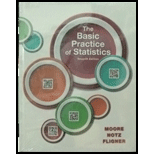
Concept explainers
a.
To obtain: The probability of winning with a bet on red in a single play of roulette.
a.
Answer to Problem 14.26E
The probability of winning a bet on red colored is 0.47.
Explanation of Solution
Given info:
The roulette wheel consists of 38 slots numbered as 0, 00 and 1 to 36 in which 0,00 are green colored, 18 are red colored and 18 are black.
Calculation:
Here, the sample size is
The probability of winning a bet on red in a single play of roulette is,
Thus, the probability of winning a bet on red colored is 0.47.
b.
To obtain: The distribution of random variable X.
b.
Answer to Problem 14.26E
The distribution of X is binomial.
| X | 0 | 1 | 2 | 3 | 4 |
| 0.0789 | 0.2799 | 0.3723 | 0.2201 | 0.0488 |
Explanation of Solution
Given info:
A bet is placed on red, every time when the roulette is played for four times.
Calculation:
Define the random variable X as the number of win, when bet is placed on red every time.
Also, there are two possible outcomes (winning the bet on red or losing the bet on red) and the probability of success is the probability that winning when placing bet on red each time (p) is 0.47 and not winning, when placing bet on red each time is 0.53
Therefore, winning when placing bet on red every time follows the binomial distribution with sample size
Thus, the value of n and p, if X has a binomial distribution is 4 and 0.47 respectively.
The probability value when
The binomial distribution formula is,
Substitute
Thus, the probability value with
The probability value when
Substitute
Thus, the probability value with
The probability value when
Substitute
Thus, the probability value with
The probability value with
Substitute
Thus, the probability value with
The probability value with
Substitute
Thus, the probability value with
Thus, the probability distribution of X is given below:
| X | 0 | 1 | 2 | 3 | 4 |
| 0.0789 | 0.2799 | 0.3723 | 0.2201 | 0.0488 |
c.
To find: The probability of break even.
c.
Answer to Problem 14.26E
The probability of break even is 0.5.
Explanation of Solution
Given info:
Break even means when same amount of bet is placed on every play and win exactly two plays out of four plays.
Calculation:
Thus, the probability of break even is 0.5.
d.
To find: The probability of losing money.
d.
Answer to Problem 14.26E
The probability of losing money is 0.3125.
Explanation of Solution
Given info:
In four plays, fewer than two are won then money will be lost.
Calculation:
Define the random variable Y “number of times the game is lost”
From part (c) the probability of losing, p is 0.5 thus, q is
The probability value for
The binomial distribution formula is,
Substitute
Thus, the probability of losing money is 0.3125.
Want to see more full solutions like this?
Chapter 14 Solutions
Bundle: Basic Practice of Statistics 7e & LaunchPad (Twelve Month Access)
 MATLAB: An Introduction with ApplicationsStatisticsISBN:9781119256830Author:Amos GilatPublisher:John Wiley & Sons Inc
MATLAB: An Introduction with ApplicationsStatisticsISBN:9781119256830Author:Amos GilatPublisher:John Wiley & Sons Inc Probability and Statistics for Engineering and th...StatisticsISBN:9781305251809Author:Jay L. DevorePublisher:Cengage Learning
Probability and Statistics for Engineering and th...StatisticsISBN:9781305251809Author:Jay L. DevorePublisher:Cengage Learning Statistics for The Behavioral Sciences (MindTap C...StatisticsISBN:9781305504912Author:Frederick J Gravetter, Larry B. WallnauPublisher:Cengage Learning
Statistics for The Behavioral Sciences (MindTap C...StatisticsISBN:9781305504912Author:Frederick J Gravetter, Larry B. WallnauPublisher:Cengage Learning Elementary Statistics: Picturing the World (7th E...StatisticsISBN:9780134683416Author:Ron Larson, Betsy FarberPublisher:PEARSON
Elementary Statistics: Picturing the World (7th E...StatisticsISBN:9780134683416Author:Ron Larson, Betsy FarberPublisher:PEARSON The Basic Practice of StatisticsStatisticsISBN:9781319042578Author:David S. Moore, William I. Notz, Michael A. FlignerPublisher:W. H. Freeman
The Basic Practice of StatisticsStatisticsISBN:9781319042578Author:David S. Moore, William I. Notz, Michael A. FlignerPublisher:W. H. Freeman Introduction to the Practice of StatisticsStatisticsISBN:9781319013387Author:David S. Moore, George P. McCabe, Bruce A. CraigPublisher:W. H. Freeman
Introduction to the Practice of StatisticsStatisticsISBN:9781319013387Author:David S. Moore, George P. McCabe, Bruce A. CraigPublisher:W. H. Freeman





